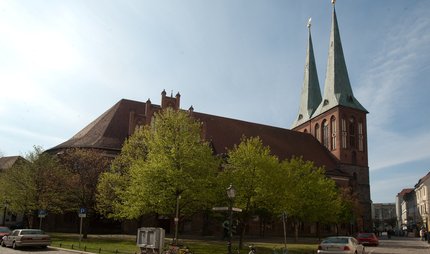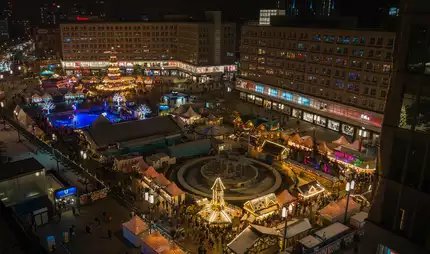
Nikolai quarter
Living urban history
Narrow streets and cosy houses – the charm of old Berlin comes to life in the idyllic Nikolaiviertel. Discover Berlin as it once was.
As you leave the busy metropolis behind you, there are small houses instead of tall buildings, narrow streets instead of wide boulevards. Only the giant Television Tower above the rooftops reminds you that Nikolaiviertel is not a romantic village but in the middle of bustling Berlin.
The idyllic Nikolaiviertel is Berlin’s oldest residential quarter, but most of its mediaeval-looking streets and quaint houses were in fact built after the war.
Nikolaikirche

The Nikolaikirche (St. Nicholas’s Church), with its striking double spire, is the heart of the quarter. Since it was rebuilt in 1987, it has housed a permanent exhibition on the history of the church and the Nikolaiviertel. Every Friday at 5 p.m. there is an organ concert entitled Zuhören – Entspannen – Nachdenken (listen - relax - contemplate).
Ephraimpalais and Knoblauchhaus

Don’t miss the most important sights: as well as the Nikolaikirche, these include the Ephraimpalais, a masterpiece of 18th century Berlin palace architecture. The Ephraimpalais, with its gently curved Rococo façade, belongs to the foundation that runs the city’s museums and houses exhibitions on Berlin’s history and culture.
Just as beautiful is the Baroque architecture of the Knoblauchhaus , built in 1760, whose rooms and valuable furniture provide a fascinating insight into the world of the Grand Burghers.
The Theater im Nikolaiviertel performs plays with a local colour – “Berlin brashness in the heart of town” is the motto of the theatre directly beside the Nikolaikirche. On its small stage you can see plays like Zille sein Milljöh and Der Insulaner verliert die Ruhe nicht, which tell typical Berlin stories with humour and élan.
When strolling around the Nikolaiviertel you can’t miss the bronze sculpture of St. George and the Dragon which decorates one of the area’s small squares.
Restaurants and cafés in the Nikolaiviertel
For a break from the urban bustle or just a pleasant evening out, the Nikolaiviertel has more than 20 restaurants, cafés and pubs – many of them with local dishes and the typical Berlin atmosphere.
The history of the Nikolaiviertel

In the middle ages, a trading route passed through Berlin at this place. Tradesmen and merchants settled where the road crossed the river. Around 1200, the Nikolaikirche was built. It was the heart of the new settlements of Berlin and Cölln on either side of the Spree, now connected by Mühlendamm.
Until the Second World War, the quarter was characterised by taverns, shops, courtyards and tradesmen’s workshops. Artists such as Kleist, Hauptmann, Ibsen, Casanova, Strindberg and Lessing lived or lodged here. Bombing raids then largely destroyed the area in 1944, and it remained a disused landscape of rubble for many years.
The ruined quarter was not restored until the run-up to Berlin’s 750th anniversary celebrations in 1987. Beginning in 1981, a team headed by the architect Günter Stahn got to work. The houses were reconstructed according to historical records, giving the illusion that a part of old Berlin had returned. The prefabricated Communist high-rises all around make it look like a dolls’ village. With its idyllic charm and many restaurants, cafés and pubs, it’s one of the city’s most popular attractions.
Nearby attractions
- Rotes Rathaus
- TV Tower
- Alexanderplatz
- St. Marienkirche
- Historic port



